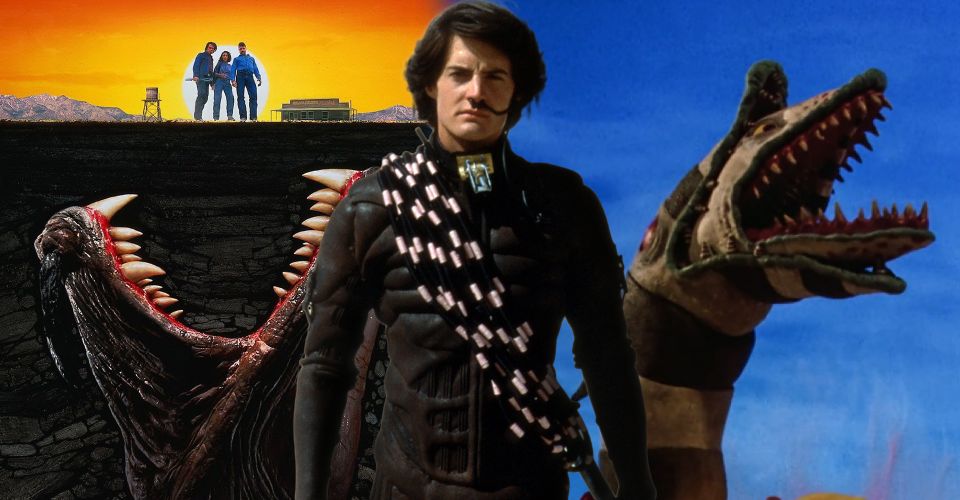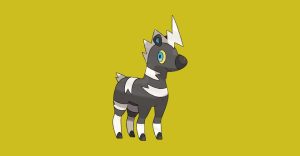Every Sci-Fi Movie That Copied Dune’s Sandworms (& Why)

Dune’s sandworms are among the most iconic science fictional monsters ever created and have inspired several creatures in other classic sci-fi movies. Frank Herbert’s 1965 novel Dune is one of the seminal works of the genre. In the novel, Paul Atreides travels with his family and the rest of House Atreides to the desert planet Arrakis, also known as Dune. Arrakis is the one planet in the entire universe that produces the drug melange, known as the spice, which makes safe interstellar navigation possible.
Key to the production of the spice are sandworms, which live in the deep deserts of Arrakis. In Herbert’s novel, the sandworms are massive, growing up to hundreds of meters in length. Their bodies are segmented and armored, and they have sharp, curved teeth. Sandworms are also worshipped by the Fremen, one of the peoples of Arrakis, who call them “Makers” or “Shai-Hulud.” The Fremen occasionally ride the sandworms as a means of travel, a skill that Paul must learn to master.
Dune: Why The Movie Is In Two Parts (Where Will Part 1 End?)
Herbert’s sandworms were inspired by treasure-guarding dragons in European legend such as the dragon in Beowulf. Just as dragons have become staples of fantasy movies, so too have sandworms become common reference points for sci-fi movies. Here are all the movies featuring sandworm-like creatures, starting with the film adaptations of Dune.
Dune (1984 & 2021)

The sandworms in David Lynch’s 1984 adaptation of Duneare what people think of when they hear the term “sandworm.” Lynch’s film accurately captures the colossal scale of Shai-Hulud, as well as the thickly armored and segmented skin. The sandworms in this version of Dune also have a trilateral mouth. This was inspired by an illustration by John Schoenherr, whose work Herbert admired.
While Denis Villeneuve’s version of Dune will not be released until 2021, the sandworm still makes a brief appearance in the film’s trailer. From what the trailer shows, this new iteration of the sandworm maintains the size and thickly armored skin of Lynch’s version. However, it has a circular mouth filled with rings of long teeth, similar to filter feeders. Villeneuve and his team reportedly spent a year perfecting the sandworm down to every last detail, so they clearly understand the importance of the sandworm and its role on Arrakis.
Beetlejuice (1988)

While not the central focus of Tim Burton’s horror comedy, sandworms still figure into Beetlejuice. When Barbara and Adam Maitland die, they discover that when they leave their house they end up in a dangerous alien desert populated by sandworms. The desert landscape combined with alien sandworms is a clear nod to Dune. During the film’s climax, Barbara rides a sandworm into the house in what could also be a reference to the Fremen practice of sandriding.
Dune vs. Avatar Is The Sci-Fi Movie Battle Of The 2020s: Who Will Win
However, Beetlejuice’s sandworms differ greatly from those featured in Dune. They are much smaller and thinner, with shark-like fins and a snake-like head. Their most distinctive attribute is their mouth: when a sandworm opens its mouth, another head emerges. The dual heads are a massive departure from Shai-Hulud, as are the colorful spots and stripes that mark this creature as most definitely being in a Burton film.
The Empire Strikes Back (1980)

It’s no secret that Star Wars was heavily influenced by Dune. The desert planet of Tatooine bears a marked resemblance to Arrakis. The evil Empire is similar to the Imperium, or Galactic Padishah Empire. Even the Force can be compared to the Voice, a vocal technique used by the Bene Gesserit to control others. Based on these similarities, it’s no wonder that Star Wars would also draw inspiration from the iconic Shai-Hulud.
In The Empire Strikes Back, Han Solo, Princess Leia, Chewbacca, and C-3PO hide in a cavern in an asteroid in order to hide from the Empire. They soon discover that they aren’t in a cave at all, but rather inside a giant space slug called an exogorth. The space slug is not very similar to Dune’s sandworms: it does not live in a desert, and its design is far more reminiscent of a whale than of a worm. However, based on Star Wars’ clear admiration of Dune, it makes sense that the exogorth acts as George Lucas’s version of Herbert’s sandworms. Similarly, the Sarlacc featured in Return of the Jedi certainly draws reference from the sandworms, with its desert location and massive rings of teeth. While markedly different from Shai-Hulud, the Sarlacc definitely stands out as yet another Dune reference housed within the Star Wars universe.
Tremors (1990)

In Tremors, subterranean monsters known as Graboids plague a small town in Nevada with a series of attacks. The Graboids in Tremors are worm-like in shape and share several behavioral traits with Shai-Hulud. Like sandworms, Graboids move quickly underground but are unable to tunnel through solid rock. Graboids also hunt by sensing vibrations, just as sandworms are attracted to steady rhythmic activity in the desert.
Physically, Graboids differ tremendously from Shai-Hulud, and for good reason. In “The Making of Tremors,” creature effects designer Alec Gillis states that “what we did not want to do was repeat what had been done in Dune.” Gillis and fellow creature effects designer Tom Woodruff Jr. took a more skeletal approach with the Graboids, giving them pointed armored heads that would allow them to easily break through dirt while traveling at high speeds. Graboids also have spines along their sides which help them move more easily through the ground. Similarly to Beetlejuice’s sandworms, Graboids’ mouths are incredibly distinctive. They have multi-pieced beaks and three prehensile tongues, each with their own set of teeth and horns. Finally, Graboids are much smaller than Shai-Hulud, only growing up to about 10 meters in length.
The Graboids in Tremors, as well as Star Wars’sspace slugs and Beetlejuice’s sandworms, all carry similarities to the gargantuan sandworms featured in Frank Herbert’s Dune and its film adaptations. Still, each of these creatures manages to distinguish itself enough that none of them are carbon copies of the original idea. Sandworms and their many iterations are proof of science fiction’s universality and of directors’ abilities to take an iconic staple of a genre and make it their own.
- Dune (2021)Release date: Oct 22, 2021
About The Author

















